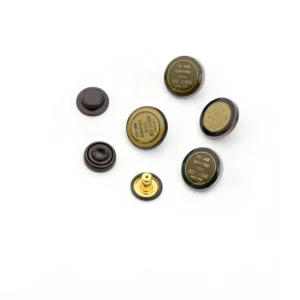Distinguishing original jeans buttons and rivets from fake or counterfeit ones can be a bit tricky, but there are a few telltale signs to look for.
Here are some tips to help you distinguish original jeans buttons and rivets:
Check the branding: Original jeans buttons and rivets will usually have the brand name or logo stamped or engraved on them. Look for clear, crisp branding that is consistent with the brand’s usual style and font.
Look for quality materials: Original jeans buttons and rivets are typically made from high-quality materials such as brass or copper. They should have a weighty feel and a smooth surface with no rough edges or burrs.
Check the finish: Original jeans buttons and rivets will usually have a consistent finish that matches the rest of the hardware on the jeans. Look for a consistent color and texture with no signs of flaking or peeling.
Examine the attachment method: Original jeans buttons and rivets will be securely attached to the jeans using a specific method, such as a prong or nail attachment. Look for a clean, tight attachment with no signs of glue or other adhesives.
Check for authenticity markings: Some original jeans buttons and rivets may have authenticity markings or codes that can help you verify their authenticity. Look for markings or codes that match the brand’s usual practice and that can be verified with the brand or by researching online.
Purchase from reputable sources: To ensure that you are getting original jeans buttons and rivets, purchase from reputable sources such as the brand’s official website or authorized retailers.
Overall, distinguishing original jeans buttons and rivets from fake ones requires careful examination and attention to detail. By looking for branding, jeans buttons and rivets quality materials, consistent finish, secure attachment, authenticity markings, and purchasing from reputable sources, you can increase your chances of getting authentic hardware for your jeans.
What are some common methods for attaching original jeans buttons and rivets?
There are several common methods for attaching original jeans buttons and rivets to denim fabric.
Here are some of the most common methods:
Nail or Prong Attachment: This is the most common method for attaching jeans buttons and rivets. In this method, the button or rivet is inserted through the fabric, and a nail or prong is then hammered down through the back of the button or rivet to securely attach it to the fabric. This method is durable and long-lasting.
Sew-On Attachment: In this method, the jeans buttons and rivets are attached to the fabric using needle and thread. The button or rivet has small holes in the base, which are used to sew it onto the fabric. This method is less durable than the nail or prong attachment method.
Snap Attachment: In this method, the jeans buttons and rivets are attached to the fabric using a snap fastener. The button or rivet has a socket on the back, which is attached to the fabric using a snap fastener. This method is less secure than the nail or prong attachment method.
Glue Attachment: In this method, the jeans buttons and rivets are attached to the fabric using an industrial-strength adhesive. This method is the least durable of all the attachment methods and is often used for decorative purposes only.
Overall, the nail or prong attachment method is the most common and durable method for attaching jeans buttons and rivets. However, the other methods can also be used depending on the specific application and the desired look or function.
